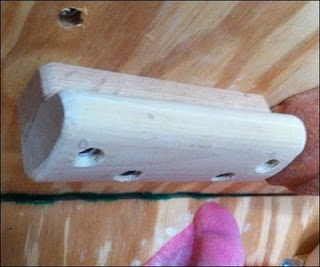1. Finger bucket for 30 degree and steeper walls.
2. Wider version of same design, placed on roof section.
While reaching up and out from the 30 degree wall below
this type of hold makes a challenging open-hand match.
this type of hold makes a challenging open-hand match.
3. Same design, but made with round hand rail for 'slabbier' walls.
Rail is flush with backing to make deeper,
comfortable open-hand edge.
4. Open hand training hold, with thin rail.
This design uses a pine 2X3, with one corner ripped off;
plus a thin oak molding.
5. I made about 10 of these open hand trainers to create
a mini system wall in the kids area of the dojo.
All of these holds are basic edges that are intended to be installed semi-permanently at particular angles, and with one face up. This is a good solution for home walls because such simple designs are easier and faster to make than general purpose holds, and they can fill in space around the bolt on holds. While basic edges are "boring" they are the most common type of hold, especially on sandstone, and are a great resource for training.The last type of the training hold [image 4. above] brings up a couple of general points about hold layout. In a home wall, you should create spaces that allow you to train in different ways. The last image shows a small section of slightly overhanging wall above a small angled roof. This a great place to work on hanging slopers, but thin edges are hard to use here because holds immediately underneath can obstruct access the thin edge or impinge on your forearm.
Placing the thin edge on the face of the sloper means that you can still access the thin edge even with a more bulky hold immediately below it. Plus, an array of these training holds let you practice similar movements from both sloping and thin open-hand edges.




